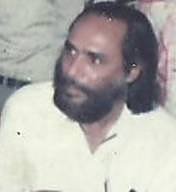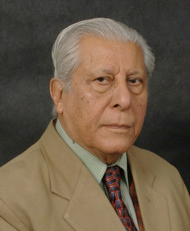
Aligarh is a city in the state of Uttar Pradesh in India. It is the administrative headquarters of Aligarh district, and lies 307 kilometres (191 mi) northwest of Kanpur and approximately 130 kilometres (81 mi) southeast of the capital, New Delhi.

Sir Syed Ahmed Taqvi bin Syed Muhammad Muttaqi KCSI, commonly known as Sir Syed Ahmed Khan, was an Islamic pragmatist, Islamic reformer, and philosopher of nineteenth century British India. Born into a family with strong debts to the Mughal court, Ahmed studied the Quran and Sciences within the court. He was awarded an honorary LLD from the University of Edinburgh in 1889.

The Masjid e Jahan Numa, commonly known as the Jama Masjid of Delhi, is one of the largest mosques in India. It was built by the Mughal Emperor Shah Jahan between 1650 and 1656 at a cost of one million rupees, and was inaugurated by Imam Syed Abdul Ghafoor Shah Bukhari from Bukhara, present-day Uzbekistan. The mosque was completed in 1656 AD with three great gates and two 40 metres high minarets constructed with strips of red sandstone and white marble. The courtyard can accommodate more than 2500 people. There are three domes on the terrace which are surrounded by the two minarets. On the floor, a total of 899 black borders are marked for worshippers. The architectural plan of Badshahi Masjid, built by Shah Jahan's son Aurangzeb at Lahore, Pakistan, is similar to the Jama Masjid.

Shibli Nomani was an Islamic scholar from the Indian subcontinent during British Raj. He was born at Bindwal in Azamgarh district of present-day Uttar Pradesh. He is known for the founding the Shibli National College in 1883 and the Darul Mussanifin in Azamgarh. Shibli was a versatile scholar in Arabic, Persian, Turkish and Urdu. He was also a poet. He collected much material on the life of the Prophet of Islam, Muhammad but could write only first two volumes of the planned work the Sirat-un-Nabi. His disciple, Syed Sulaiman Nadvi, made use of this material and added to it and also wrote remaining five volumes of the work, the Sirat-un-Nabi after the death of his mentor.

New Karachi Town is a town in the northern part of Karachi, Sindh, Pakistan. New Karachi Town is located between the Lyari River, the Manghopir Hills and two major roads – Surjani Road to the north and Shahrah-e-Zahid Hussain to the south. To the north and west lies Gadap Town, and to the south lie the towns of Gulberg Town and North Nazimabad Town. The population of New Karachi Town was estimated to be more than 680,000 at the 1998 census. Muhajirs constitute an overwhelming majority of the population.

The Jama Masjid is a mosque in the Kalbadevi neighborhood, near Crawford Market in the South Mumbai region of Mumbai, India.
Anjuman-i-Himayat-i-Islam or Anjuman-e-Himayat-e-Islam is an Islamic intellectual and social welfare organisation with branches both in India and Pakistan. It was founded in Lahore on 24 September 1884 in a mosque known as Masjid Bakan inside Mochi Gate, Lahore, by Khalifa Hameed-ud-Din.

Sir Thomas Walker Arnold was a British orientalist and historian of Islamic art who taught at Muhammadan Anglo-Oriental College, Aligarh Muslim University, and Government College University, Lahore. He was a friend of Sir Syed Ahmed Khan, and wrote his famous book "The preaching of Islam" at the insistence of Sir Syed. He also taught poet-philosopher Muhammad Iqbal and Syed Sulaiman Nadvi, and was a very close friend of Shibli Nomani who was also a teacher at Aligarh.
The All India Muhammadan Educational Conference was an organisation promoting modern, liberal education for the Muslim community in India. It was founded by Sir Syed Ahmed Khan, also the founder of the Aligarh Muslim University. All India Mumammadan Educational Conference was the origin of the All-India Muslim League. The Muslim League was born in the 20th session of All India Muhammadan Educational Conference, which was established by Syed Ahmed Khan in Aligarh in 1886. Muhammadan Educational Conference used to hold its annual meetings in various cities where, by the co-operation of local Muslims, steps were taken for the progress of education.
Minto Circle, officially Syedna Tahir Saifuddin School , is a semi-residential high school under Aligarh Muslim University at Aligarh, Uttar Pradesh, India. The school was established as Muhammadan Anglo-Oriental Collegiate School by Sir Syed Ahmad Khan in 1875, which later evolved as Aligarh Muslim University. It is one of the five senior secondary schools run by the university.

Israr Ahmad was an Indian theoretical nuclear physicist and professor at Aligarh Muslim University since 1961. He was known for his work in quantum scattering theory.

Jamal Khwaja is a retired Indian philosopher.
The Aligarh Institute Gazette was the first multilingual journal of India, introduced, edited, and published in 1866 by Sir Syed Ahmed Khan which was read widely across the country. Theodore Beck later became its editor.
Tehzeeb-ul-Ikhlaq was a journal published by the Muslim reformer Sir Syed Ahmed Khan between 1871 and 1897. The journal published alternative Muslim perspectives, written in plain language. It gave voice to the publisher's religious, social, and reforming opinions, and is credited with establishing him as one of the fathers of Urdu fiction. The same journal was restarted by Syed Hamid Vice-chancellor of Aligarh Muslim University in 1981; and since then it is being published regularly. There is now a separate office of Tehzeeb-ul-Ikhlaq.

Bhadeya is a country side locality in Gaya district of Bihar, India. Bhadeya is located in Barachati, Gaya, in the state of Bihar in northern India. Bhadeya includes Bhadeya, Karma and its localities of Azizabad, Karimgunj, Ansar Nagar, Zahoorabad. It also comprises Sondiha, Paili, Chhaura Bandh, Bigha, Imamgunj, Gaiwal Karma, Hasanpur, Mananbigha.
Akhtarul Wasey was a professor of Islamic studies who taught at Jamia Millia Islamia in New Delhi. Currently he is working as President of Maulana Azad University, Jodhpur, India and as a Professor Emeritius in the Department of Islamic Studies in Jamia Millia Islamia. As a versatile personality he assumed many formal and informal designations. Formerly he worked as the director of Zakir Husain Institute of Islamic Studies at Jamia Millia Islamia, Vice-chairman of the Urdu Academy Delhi and a Member of the Executive Board of National Council for Promotion of Urdu Language. And was also, Vice-president of Foundation of SAARC Writers and Literature, India Interfaith Coalition on HIV/AIDS etc. Previously he was also the President of Dargah Committee of the world-famous Chishti Sufi Shrine at Ajmer, treasurer of Maulana Azad Education Foundation, General Secretary of South Asia Inter-religious Council on HIV/AIDS, a body created by the UNICEF, and head of the Department of Islamic Studies and Dean of Faculty of Humanities and Languages, Jamia Millia Islamia. Wasey has been invited to 70 academic and semi-academic tours abroad including programmes organized/sponsored by UNICEF, UNDP, UNAIDS, UNFP, UNHRC and Organization of Islamic Conference. He was also the editor of four journals of Islamic Studies, Islam Aur Asr-e-Jadeed, Islam and the Modern Age, Risala Jamia, and Islam Aur Adhunik Yug (Hindi). Apart from his academic achievements he regularly appears on TV, debating on issues related to Islam and Muslims, and has delivered over 400 radio and 300 TV talks along with extensive and frequent writings in different news papers and magazines. He is considered to be a Muslim spokesperson among academicians. In 2013 Wasey received a Padma Shri award from President Pranab Mukherjee, honouring him as a distinguished academician, specializing in the multidisciplinary study of Islam and Indian Muslims.
Raja Jai Kishan Das Chaube, CSI, Rai Bahadur was an Indian administrator and close associate of Sir Syed Ahmad Khan, founder of Aligarh Muslim University.

Jama Mosque is one of the biggest mosque in Himachal Pradesh located in Kotwali Bazar, Dharamshala, India.
The Aligarh Movement was the push to establish a modern system of education for the Muslim population of British India, during the later decades of the 19th century. The movement′s name derives from the fact that its core and origins lay in the city of Aligarh in Northern India and, in particular, with the foundation of the Mohammedan Anglo Oriental College in 1875. The founder of the oriental college, and the other educational institutions that developed from it, was Sir Syed Ahmed Khan. He became the leading light of the wider Aligarh Movement.
Muhammadan Anglo-Oriental College was founded in 1875 by Sir Syed, initially as a primary school, with the intention of taking it to a college level institution, known as Muhammedan Anglo Oriental Collegiate School. Its given Urdu name was Madrasatul Uloom Musalmanan-e-Hind. It started operations on Queen Victoria's 56th birthday, 24 May 1875.











